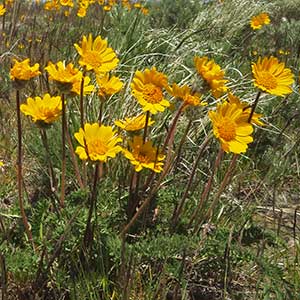Balsamorhiza macrophylla
Balsamorhiza hookeri
large-leaf balsamroot
Hooker's balsamroot
up to 35 cm, tomentose; from single taproot.
11–47 cm; hirsute; from single taproot.
lanceolate-oblong, 1-pinnately divided;
pinnae toothed, with teeth only on lower margins;
surfaces tomentose;
basal leaves in 1–few rosettes;
blades 12–22 × 6–8 cm;
pinnae 10–36 mm wide;
petioles 7–20 cm;
cauline blades 1.5–5 × 0.3–0.9 cm;
petioles 6–9 cm.
lanceolate to ovate-lanceolate, 1-pinnately divided with some pinnae toothed or lobed to 3-pinnately lobed;
margins entire to crenate or serrate;
surfaces hirsute to hirsute-sericeous;
basal leaves in 1–few rosettes;
blades 12–24 × 4–12 cm;
pinnae 1–10 mm wide;
petioles 4–15 cm;
cauline blades 3–14.5 × 0.6–4 cm;
petioles 4–11 cm.
with 1 terminal head.
with 1 terminal head.
14–18 × 25–30 mm.
8–15 × 15–25 mm.
14–16, yellow;
rays 35–40 × 8–11 mm.
deciduous, 10–17, yellow;
rays 15–30 × 4–7 mm.
~9 mm.
~6 mm.
ovate-lanceolate, 20–25 × 5–6 mm;
tips acuminate, tomentose.
linear-lanceolate to ovate, 13–20 × 3–6 mm, with or without long-acuminate tips, villous-hirsute and ciliate, sometimes glabrous proximally.
8–9 mm, glabrous.
6.5 × 1.5 mm, glabrous.
10–12 mm.
11–12 mm.
=100 ± 2.
=38.
Balsamorhiza macrophylla
Balsamorhiza hookeri
Dry, open areas. Flowering May–Jul. 700–1400 m. BW. ID; east to WY. Native.
True B. macrophylla is a decaploid centered on the Wasatch Mountains in Utah and Idaho. The plants in Oregon and western Idaho are also high polyploids, but they differ morphologically from classic B. macrophylla in their denser pubescence and the shape of their leaves. These eastern plants have been given the name B. macrophylla var. idahoensis. However, further study will likely show that they have a different parentage than B. macrophylla s.s. The specific epithet “macrophylla” means large-leaved, as the leaves are much larger than those of the other members of section Balsamorhiza.
Dry, open, often rocky areas. Flowering Apr–Jun. 1000–1600 m. BR, BW. CA, ID, NV, WA; southeast to UT. Native.
As treated here, B. hookeri consists of the members of section Balsamorhiza that are left over after the entities that are distinct in at least some parts of their ranges are removed. Balsamorhiza hookeri hybridizes with B. hispidula and B. sagittata. The species is named after the British botanist William Jackson Hooker, who initially described it as Heliopsis balsamorhiza and tentatively proposed (but did not validly publish, as he did not accept it) the genus Balsamorhiza under the supposition that it would prove to be distinct from Heliopsis once better material was collected.
Abigail (Abby) Moore
Abigail (Abby) Moore




